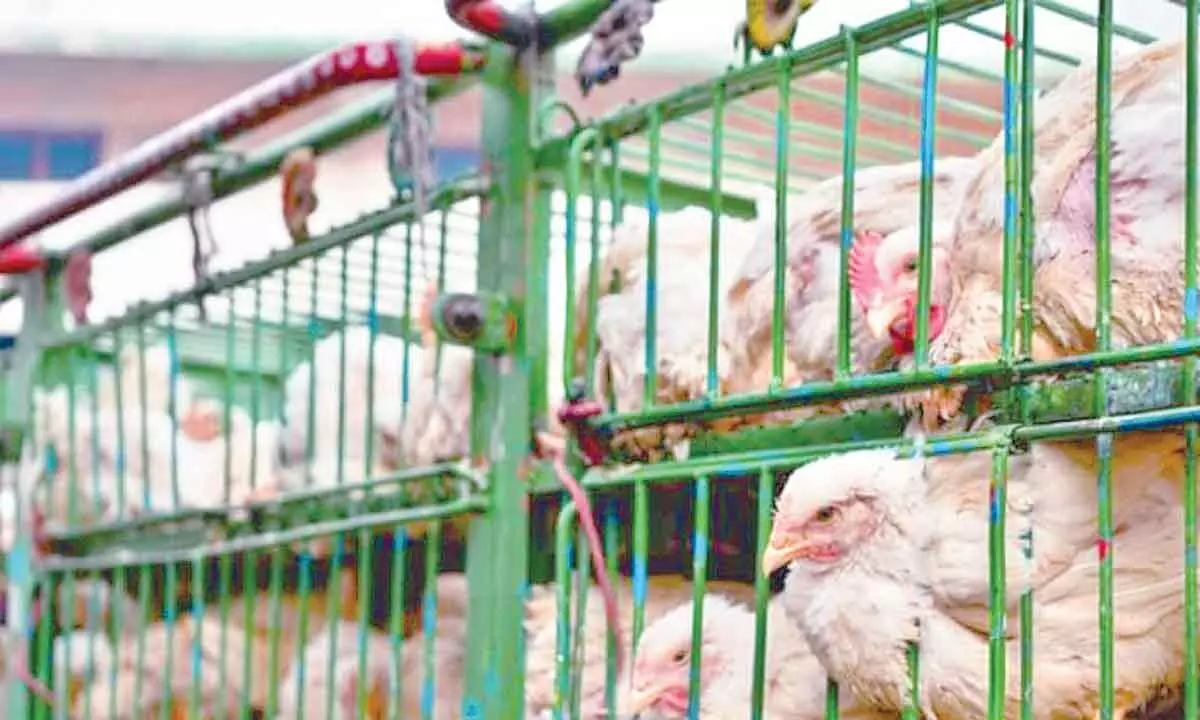Caged birds in a horrible state

Butter chicken and Tandoori chicken are two of the favourite mouth-watering dishes that have won Indian hearts and taste buds.
Butter chicken and Tandoori chicken are two of the favourite mouth-watering dishes that have won Indian hearts and taste buds. Internationally too, tender chicken has emerged as the most popular meat among consumers. Low in calories but rich in nutrients, chicken is a growing industry.
Such is the growth of the chicken industry that its production in India had doubled between 2003 and 2013, and subsequently grew to 4.3 million tonnes in 2019-20. While the finger-licking recipes are drawing more people to make chicken a regular part of their diet, if only they were apprised of the appalling conditions in which chickens are raised, the growth in consumption rate will perhaps drop considerably. And this will force the chicken industry to raise the birds in a more humane manner.
That chickens are raised in 'battery cages' of the size of an A4 page is well known. With their beaks cut off, poultry birds are crammed in cages which disable hens to 'perform innate behaviours such as wing-flapping, dust-bathing, stretching, foraging, perching and nesting," says a report in the British daily The Mirror, adding that 'parts of their beaks are also removed to stop them pecking out feathers.'
As a student of agriculture I remember I was told that cutting the beak of poultry birds was necessary to see that the birds do not injure themselves during a fight. Anyway, the newspaper quoted an animal activist saying: "It is a terrible life. No feathers, totally in shock and kept in the dark for long periods. It is like they have been kept in a Nazi concentration camp." Shockingly 14-million hens are still crammed in cages across UK.
While all major retailers and food companies have promised to stop selling eggs from caged birds by 2025, the European Union is contemplating bringing tougher legislations that ban eggs from caged hens by 2027. Besides poultry, it also includes animals like pigs, rabbits, ducks and geese. Even though it is still a few years away, animal right activists in UK and Europe have successfully managed to draw the public ire to the extent of cruelty that animals are faced with in factory farming.
In India too, animal rights activists have in 2019 through a Delhi High Court order directed the Ministry of Agriculture to draft rules that prohibit keeping hens in 'battery cages'. While a lot is still expected in the implementation of that directive, it is also the lack of public awareness that has come in the way of industry to exercise its responsibility to fix the problem and change for the better.
A very educative and illustrative Twitter thread by an Italy-based twitter handle @Sollozzo opened my eyes to the brutality that the poor chicken, howsoever tender it may be, has to undergo during its lifespan. While the thread is about the chicken industry in the US, I think it tells you clearly how over the years the chicken we are made to eat has a profound impact on our health. The nutritious chicken of today is 'bland', 'dry' and 'flavourless' compared to the chicken our parents used to eat before the 1960s, which were a delicacy. In one of the tweets, he quotes the then famed Chef Julia Child who said: "Chicken should be so good in itself that it is an absolute delight to eat as a perfectly plain, butter roast, sauté or grill."
While the US is obsessed with chicken, eating 26 billion pounds of chicken every year, a question that the twitter writer asks is how we ended with these fattened, flavourless birds that are dirty and pumped with hormones. To this, he himself provides the answer: the chicken you are eating today has increased 364 per cent in size over the last 50 years. In 1957, the average broiler weighed 905 gm; in 1978 its weight increased to 1,808 gm; and in 2005 a broiler on an average weighs around 4,202 gm. Simply put, the average weight of a broiler has grown almost 4.64 times. As Felicity Lawrence in an article in The Guardian writes: "By day nine, the broiler legs can barely keep its oversized breast off the ground, by day 35 it looks more like a weightlifter on steroids and dwarfs the egg-laying hen." Returning back to the twitter thread, we are told that short legs and heavy breast makes the broiler wobble as it tries to walk. The birds become so huge, often weighing around 6.5 pounds, and are ready for slaughter at day 47. Compare this to the chicken of the past, when chicken were allowed to mature the way they normally do, and slaughtered when they reach an age of 4 months plus.
Unlike the free roaming chickens, the chickens of today are fed with soya and corn, additionally with more carbohydrates to provide them with 'high-energy diets'. While the reduction in the broiler's lifespan is what produces the bland flavouring, the high-energy diet helps in bringing efficiency thereby making the chicken ready quickly. The faster the bird is brought to the supermarket shelves, the higher is the amount of dollars earned by the food companies.
The writer says the industrialisation of chicken farming is what has led to the production of genetically-modified Frankenbirds. Derived from two popular breeds, these broilers are developed to grow fast and as well as grow fat as quickly as possible. Unlike in the past, when the Indian breed Brahma used to dominate the broiler breeds, today the broilers are bred keeping cost-efficiency in mind. A lot of hormones and antibodies are used to ensure that the chickens are ready in time. In India, the Bureau of Investigative Journalism blames unregulated sales of antibiotics for human and animal use that it has been called as the epicentre of the global drug resistance crisis.
Accordingly, India's consumption of antibiotics in chickens is expected to grow fivefold between 2020 and 2030. In the same period, globally it is expected to increase by 53 per cent. It quotes a professor from the Centre for Disease Dynamics, economics and Policy in New Delhi saying that in an average poultry farm in Punjab, farm owners use antibiotics as a substitute for keeping the animals alive. This is leading to more and more people developing antibiotic resistance.
A consumer therefore must realise that the chicken they love to eat is not brought up in healthy conditions. A safe and healthy chicken is what they need, and this can happen only when they wake up to what they are eating.
(The author is a noted food policy analyst and an expert on issues related to the agriculture sector. He writes on food, agriculture and hunger)

















